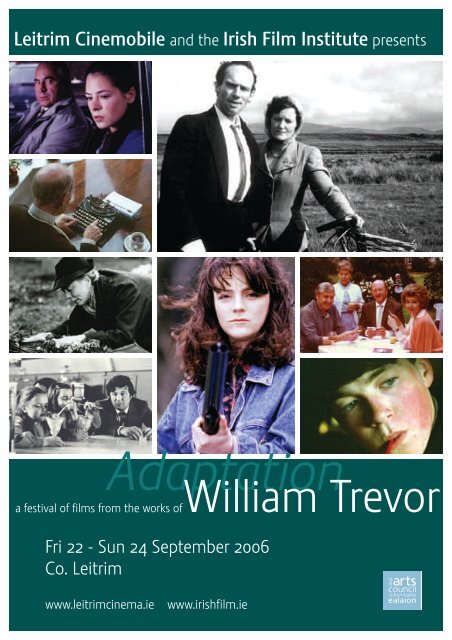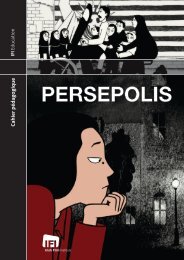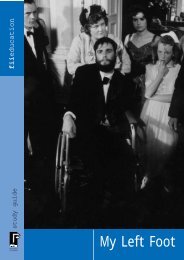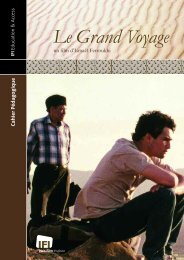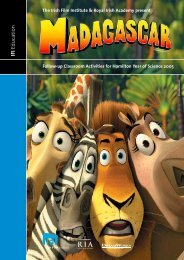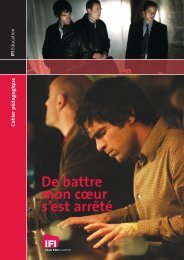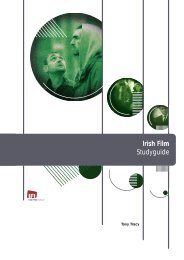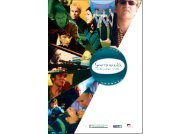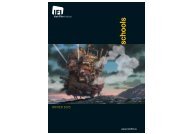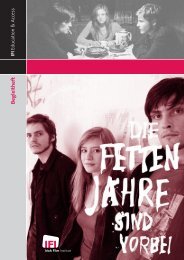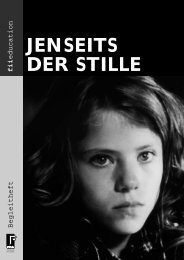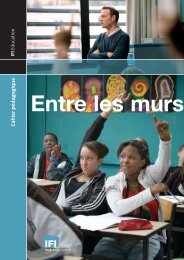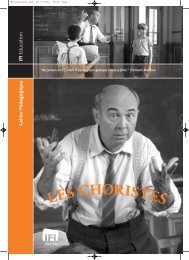Adaptation - Irish Film Institute
Adaptation - Irish Film Institute
Adaptation - Irish Film Institute
You also want an ePaper? Increase the reach of your titles
YUMPU automatically turns print PDFs into web optimized ePapers that Google loves.
Leitrim Cinemobile and the <strong>Irish</strong> <strong>Film</strong> <strong>Institute</strong> presents<br />
<strong>Adaptation</strong><br />
a festival of films from the works ofWilliam Trevor<br />
Fri 22 - Sun 24 September 2006<br />
Co. Leitrim<br />
www.leitrimcinema.ie<br />
www.irishfilm.ie
Introduction<br />
In setting out on our second year it is only right to mention John McGahern, last year’s<br />
featured writer. In retrospect our collaboration with him for our debut festival proved not just<br />
fitting, but timely. What a gracious and inspirational subject he proved to be.<br />
This year’s <strong>Adaptation</strong> festival pays tribute to one of the country’s most prolific and<br />
most adapted writers, William Trevor. Due to a long-standing engagement he is regretfully<br />
unable to attend. However, in a development from last year’s festival, the event will benefit<br />
from the involvement of some of those key talents and professionals responsible for bringing<br />
these works to the screen: Robert Cooper who for many years performed the role of a oneman<br />
film studio at BBC N. Ireland, celebrated actor Tom Hickey and of course Pat O’Connor,<br />
one of a small band of <strong>Irish</strong> directors to cut a consistent international profile over the past<br />
twenty years.<br />
While clearly keeping our focus on the festival as an event with broad audience and<br />
national appeal, this event comes at a time of change for the local film scene in Leitrim and<br />
the North West. The Dromahaire based team of Marian Quinn and Tom Weir are on course to<br />
complete their debut feature film for 2007 release, proving<br />
that a film industry can become increasingly de-centralised.<br />
Meanwhile a multi-screen cinema opens in Carrick-on-<br />
Shannon in October, helping to undo the loss of the town’s<br />
Gaiety Cinema in 2004. With the opening of new<br />
commercial screens cinemobile will be in a position to<br />
concentrate on its more diverse activities - the provision of<br />
World Cinema as well as a growing educational function.<br />
To this end we are delighted to welcome the <strong>Irish</strong><br />
<strong>Film</strong> <strong>Institute</strong> as our full partners in this year’s <strong>Adaptation</strong><br />
Festival. I would like in particular to thank <strong>Irish</strong> <strong>Film</strong> Archive<br />
Curator and cinemobile Board Member Sunniva O’Flynn and<br />
her colleague and newly appointed Regional Development<br />
Manager at the <strong>Irish</strong> <strong>Film</strong> <strong>Institute</strong> Alice Black for their<br />
contribution to the festival. We look forward to their future<br />
collaboration in bringing the full diversity of cinema to local<br />
audiences in the region in our own adaptation to a<br />
changing and improving scene.<br />
Johnny Gogan<br />
Chair, Leitrim Cinemobile<br />
Thanks; Glenfarne Community Development Trust, Sean McDermott CC, Gerry Finneran,<br />
Fowleys Garage, Dromahaire, Clancys Restaurant Glenfarne, Leitrim Couny Council,<br />
Dromahaire and Manhormilton Book Clubs.<br />
Cinema Manager: Tommy Aherne<br />
Event Management: Bandit <strong>Film</strong>s
Ballroom of Romance<br />
Year<br />
Length<br />
Production Company<br />
Director<br />
Producer<br />
Screenplay<br />
Cast<br />
Synopsis<br />
1982<br />
65 minutes<br />
RTÉ /BBC<br />
Pat O'Connor<br />
Kenith Trodd<br />
William Trevor<br />
Brenda Fricker, John Kavanagh, Cyril Cusack,<br />
Niall Toibin, Mick Lally<br />
This moving and funny drama was warmly received<br />
by audiences and critics alike when it was first shown<br />
by RTE in 1982.<br />
Bridie has visited the local ballroom every Friday<br />
night since she was sixteen. Tonight she suddenly<br />
sees the ball room in a new light. For many rural<br />
inhabitants ballrooms represented a temporary<br />
escape from the monotony and isolation of everyday<br />
life. However, often they also cruelly emphasised the<br />
despair and frustration experienced within many rural<br />
communities.<br />
With remarkable performances from an ensemble<br />
cast this sensitive piece won the Silver Drama Award<br />
in New York, and a BAFTA for best single play.
Hidden Ground<br />
Year<br />
Length<br />
Production Company<br />
Producer<br />
Synopsis<br />
1990<br />
30 minutes<br />
BBC Northern Ireland<br />
Tom McAuley<br />
In this beautifully crafted documentary we are taken<br />
on a journey by William Trevor as he explores the<br />
landscape of his childhood in County Cork, visiting<br />
Mitchelstown, Youghal and Skibbereen.
Attracta<br />
Year<br />
Length<br />
Production Company<br />
Director<br />
Producer<br />
Screenplay<br />
Cast<br />
Synopsis<br />
1983<br />
55 minutes<br />
B.A.C. <strong>Film</strong>s<br />
Kieran Hickey<br />
Douglas Kennedy<br />
William Trevor<br />
Wendy Hiller, Kate Thompson, John Kavanagh, Kate<br />
Flynn, Deirdre Donnelly, Cathleen Delaney<br />
Redemption and the pain of a wasted life are the<br />
disturbing themes of this adaptation of William<br />
Trevor's short story. An ageing spinster teacher,<br />
Attracta, fastidiously played by Wendy Hiller, cracks<br />
under the strain when she realises too late her failure<br />
to teach generations of <strong>Irish</strong> pupils that good can<br />
come out of the most horrific sectarian violence.
Genevive MacKenzie as Susie, Clare O'Dea as Deirdre and Donal MacCann as Malcomson © RTÉ Stills Library<br />
<strong>Irish</strong> Love Stories:<br />
Access to the Children<br />
Year<br />
Length<br />
Production Company<br />
Director<br />
Producer<br />
Screenplay<br />
Cast<br />
Synopsis<br />
1985<br />
60 minutes<br />
RTÉ / Channel Four / Bayfilm Partnership<br />
Tony Barry<br />
John Lynch<br />
William Trevor<br />
Donal McCann, Clare O'Dea, Genevive McKenzie,<br />
Dearbhla Molloy, Judi Bowker<br />
Malscolmson has left his wife and children for a<br />
younger woman. He has access to the children and<br />
takes them out each Sunday. He gradually realises<br />
that he still loves his wife and on this Sunday suggest<br />
to her that they re-establish their marriage.
One of Ourselves<br />
Year<br />
Length<br />
Production Company<br />
Director<br />
Producer<br />
Screenplay<br />
Cast<br />
Synopsis<br />
1983<br />
49 minutes<br />
BBC Northern Ireland<br />
Pat O'Connor<br />
Kenneth Trodd<br />
William Trevor<br />
Cyril Cusack, Niall Toibin, Tom Hickey, Pat Leavy, Bill<br />
Paterson, Stephen Mason<br />
Originally entitled An Evening with John Joe<br />
Dempsey, this television adaptation is a coming-ofage<br />
story featuring John Joe Dempsey on the<br />
occasion of his fifteenth birthday. At his happiest<br />
when alone with his fantasies or when keeping<br />
company with the town eccentric, Quigley, John Joe is<br />
at a turning point in his life and under pressure to<br />
give up both fantasies and friend to become "one of<br />
ourselves" in the town. – Helena Sheehan, <strong>Irish</strong><br />
Television Drama: A Society and its Stories
Events At Drimaghleen<br />
Year<br />
Length<br />
Production Company<br />
Director<br />
Producer<br />
Screenplay<br />
Cast<br />
Synopsis<br />
1991<br />
60 minutes<br />
BBC Northern Ireland / RTÉ<br />
Robert Cooper<br />
Robert Cooper<br />
William Trevor<br />
Sophie Ward, T.P. McKenna, Hugh Fraser, Nick<br />
Dunning, Kate Binchy, Pat Laffan, John Kavanagh<br />
The painful memories of the tragedy that awaited the<br />
people of Drimaghleen on 2/11/88 have just begun to<br />
fade; Hetty Fortune and her TV documentary team<br />
travel there to piece those memories together into a<br />
story of horror.
Fools of Fortune<br />
Year<br />
Length<br />
Production Company<br />
Director<br />
Executive Producer<br />
Screenplay<br />
Cast<br />
Synopsis<br />
1990<br />
109 minutes<br />
Polygram / Working Title / Fools of Fortune Ltd.<br />
Pat O'Connor<br />
Sarah Radclyffe, Tim Bevan, Graham Bradstreet<br />
Michael Hirst<br />
Iain Glenn, Mary Elizabeth Mastrantonio, Julie<br />
Christie, Tom Hickey, John Kavanagh<br />
Willie Quinton's life has fallen apart. During the War<br />
of Independence the Black and Tans murdered his<br />
father and two younger sisters at their Big House in<br />
Kilneagh. He and his mother Evie now live in quiet<br />
desperation in Dublin. The family's maid, Josephine,<br />
looks after them.<br />
He falls in love with his beautiful cousin Marianne<br />
Woodcombe, whom he invites to Kilneagh despite<br />
his mother's ravings about having no time for these<br />
disruptions, constantly fantasising about her<br />
husband's murderer, Sergeant Rudkin.
Beyond The Pale<br />
Year<br />
Length<br />
Production Company<br />
Director<br />
Producer<br />
Screenplay<br />
Cast<br />
Synopsis<br />
1989<br />
60 minutes<br />
BBC Northern Ireland<br />
Diarmuid Lawrence<br />
Robert Cooper<br />
William Trevor<br />
Annette Crosbie, Prunella Scales, Sheila McGibbon<br />
Milly and her friends have been going on holiday<br />
together for years. However on this occasion their<br />
peace is shattered when a terrible secret is revealed<br />
concerning themselves and the Troubles in Northern<br />
Ireland.
August Saturday<br />
Year<br />
Length<br />
Production Company<br />
Director<br />
Producer<br />
Screenplay<br />
Cast<br />
Synopsis<br />
1990<br />
60 minutes<br />
BBC Northern Ireland<br />
Diarmuid Lawrence<br />
Robert Cooper<br />
William Trevor<br />
Sorcha Cusack, Tim McInnery, Barry McGovern,<br />
John Kavanagh, Bairbre Ní Chaoimh<br />
On the third Saturday of every month a group of<br />
close friends have dinner together in the function<br />
room of the Tara Hotel. All are in their early 40s, and<br />
one couple, Grania and Desmond, who were childless<br />
for many years, experienced happiness by the birth of<br />
a daughter 14 years previously. However, 15 years<br />
previously, an Englishman called Prendergast made a<br />
fleeting visit to the town, and his unexpected<br />
reappearance causes great consternation to Grania and<br />
fear of the terrible consequences his return may have<br />
for her an her family.
Felicia's Journey<br />
Year<br />
Length<br />
Production Company<br />
Director<br />
Producers<br />
Screenplay<br />
Cast<br />
Synopsis<br />
1999<br />
116 minutes<br />
Alliance Atlantis / Icon Productions / Marquis <strong>Film</strong>s /<br />
Screenventures XLIII<br />
Atom Egoyan<br />
Paul Tucker, Ralph Kamp, Bruce Davey, Robert Lantos<br />
Atom Egoyan<br />
Bob Hoskins, Elaine Cassidy, Claire Benedict, Bríd Brennan,<br />
Peter McDonald, Gerard McSorley, Arsinée Khanjian<br />
A solitary middle-aged bachelor and a naive <strong>Irish</strong> teenager<br />
transform one another's lives to arrive at a place of recognition, redemption<br />
and wisdom in Felicia's Journey, writer/director Atom Egoyan's adaptation of<br />
William Trevor's celebrated 1994 novel Stumbling through the beautifully<br />
rendered industrial Midlands, England, in clunky platform shoes, hair<br />
fashioned in a childlike ponytail, the young <strong>Irish</strong> Felicia (Cassidy) ploughs<br />
along in search of the boyfriend whose child she is carrying. Along the way<br />
she meets the kindly, middle-aged Joseph Hilditch who offers to help her<br />
find her love. However, all is not as it seems--the mild-mannered catering<br />
manager of a large factory is, in fact, unhinged.<br />
What was interesting about, say, Felicia's Journey, is that the option had<br />
been secured by a producer without having ever had any contact with the<br />
writer; and when I took on that project they were surprised that I would<br />
want to meet William Trevor. But William Trevor is one of the greatest<br />
writers working in the English language; so I couldn't resist the opportunity<br />
to have his input. I mean, if a writer is prepared to read a draft and to<br />
comment on it, why wouldn't you want that input<br />
“I think the frightening thing is considering, you know, what if the writer<br />
came back and said, "This is a complete travesty -- a betrayal of everything<br />
I wanted this book to be!" Then you have a real decision to make, which is<br />
whether or not to consider that, or reject it. Thankfully, I've never been in<br />
that situation.”<br />
- Atom Egoyan, Creative Screenwriting 10/14/05
<strong>Irish</strong> <strong>Film</strong> <strong>Institute</strong> Goes Regional<br />
As the newly appointed Regional Development Manager for the <strong>Irish</strong> <strong>Film</strong> <strong>Institute</strong>, I was<br />
honoured when Johnny Gogan, Chair of the Leitrim Cinemobile, asked me to become involved<br />
in <strong>Adaptation</strong>, their annual event celebrating cinematic adaptations of <strong>Irish</strong> writers. Impressed<br />
by last year’s McGahern programme, I was delighted when he told me that a showcase of<br />
William Trevor in film was being planned.<br />
With the assistance of my colleagues Sunniva O’Flynn and Kasandra O’Connell in the <strong>Irish</strong> <strong>Film</strong><br />
Archive, we began the search for available material. A number of the films had been preserved<br />
and stored in our own collection while others were located with the help of Jo Wheatley in the<br />
RTE archives. Special thanks must be made to Kevin Jackson and Oonagh McMullan from the<br />
Drama department of BBC Northern Ireland who provided us not only with so many of the<br />
gems included in this programme, but also images, information and invaluable advice. This<br />
project was made possible by the collaboration of these three archives and is a perfect<br />
example of the important role they play as the keepers of our heritage.<br />
The <strong>Irish</strong> <strong>Film</strong> <strong>Institute</strong> continues to be committed to developing and reaching audiences for<br />
film culture nationwide. Thanks to generous support from the Arts Council, this Autumn we<br />
will be expanding our touring schedule, bringing events like the Stranger Than Fiction<br />
Documentary Festival and community projects like Wild Strawberries, our film club for older<br />
audiences, to a cinema near you. IFI Regional is always looking for opportunities to collaborate<br />
with our regional partners like the Leitrim Cinemobile in creating new projects which celebrate<br />
local film interests. I would welcome contact from any community organisation or cinema<br />
exhibitor who is interested in participating in an IFI regional tour or would like help in fostering<br />
a local project.<br />
When I wrote to Mr. Trevor to let him know of our plans, he was most complimentary about<br />
our efforts, graciously allowed us to include the piece which you will read in this brochure and<br />
wished us well. Having long been a fan of Trevor’s written words, I am looking forward to the<br />
opportunity to see his characters come alive on the big screen. The films that feature in the<br />
programme are wonderful examples of <strong>Irish</strong> talent behind and in front of the camera as much<br />
as they are of William Trevor’s wonderful stories. We are delighted that many of those<br />
involved in the productions will be able to join us on this great occasion.<br />
It has been a great privilege to be involved in this event and I am looking forward to watching<br />
this collection of important <strong>Irish</strong> films in the comfort of the Cinemobile, nestled in the<br />
beautiful Leitrim landscape.<br />
Alice Black<br />
Regional Development Manager<br />
Email: ablack@irishfilm.ie
Magic Lanterns by William Trevor<br />
My brother and I were given a cinematograph, an<br />
inexpensive toy that promised hours of wholesome<br />
winter fun. It came with off-cuts of films featuring<br />
Red Indians on horseback, and was lit by a tricky<br />
arrangement of torch battery and bulb. You<br />
darkened the room, turned a handle, and the<br />
Indians appeared on the wallpaper, waving<br />
tomahawks and chasing something that never<br />
came into the picture.<br />
The conjunction between bulb and battery regularly<br />
failed, or the film jammed and tore, or the<br />
repetition of the Indians’ pursuit of the unknown<br />
became tedious, even when the film was run<br />
backwards. So we scraped at both sides of the offcuts<br />
with a penknife, ridding them of the galloping<br />
Indians and leaving us with transparent strips of<br />
celluloid. On these we inscribed with pen and ink a<br />
series of grimacing match-stick figures, which jerkily<br />
changed position on the wallpaper. Inspired, we<br />
added red ink to blue, and Technicolor came to our screen.<br />
Photo: Kennys Bookshop and Art Galleries Ltd<br />
That was my first working association with the world of film, although I had long delighted in<br />
Gracie Fields marching the citizenry through the streets, and Jack Buchanan dancing his heart<br />
out, and a strange film in which a man was shot over the telephone.<br />
Going to the pictures was the best thing in the world: the smell of old cigarettes on a sunny<br />
afternoon, the curtainless screen, the scratchy music before there was the Western Electric<br />
Sound, the sleepy MGM lion, the searchlights of 20th Century Fox.<br />
In 1940, in the town of Tipperary , the cinema went up in flames, taking with it Clark Gable and<br />
Norma Shearer in Idiot's delight. But Mr Evans, a bicycle-shop proprietor, built a new one, with<br />
baskets of flowers suspended from the hugely jutting ledge that formed a roof above pale<br />
marble steps, and a motif of butterflies on curtains that marvelously changed colour several<br />
times before each programme began. Mr Evans called his masterpiece the Excel. Forty-five<br />
years later I changed the name and changed Mr Evans as well, but if the novella I called Nights<br />
at the Alexandra is dedicated to anyone it is that wartime entrepreneur and benefactor. For<br />
three nights in a row and twice on Saturdays Nelson Eddy sang in the beautiful Excel. James<br />
Cagney was the hero of the Fighting 69th there, Robert Donat and Rosalind Russell were<br />
married there. Edna May Oliver chased the donkeys from her green, Vivien Leigh sank into<br />
prostitution, Destry rode again. And yet to come were They Died With Their Boots On and<br />
Random Harvest, and the Yacht Club Boys in Coconut Grove.
Today, when earnest PhD students or media interviewers ask about influences, I say there are<br />
two: the detective stories and thrillers I read when I should have been reading such works as<br />
The Cloister and the Hearth, and the way in which films are made.<br />
Playing about with words on paper is not wholly unlike playing about with celluloid. You cut as<br />
a film editor cuts. As the narrative develops, your own first images have to go if they aren't the<br />
right ones any more. You change the order of scenes. You remove what has become clutter, as<br />
easily as you once scraped away Indians with feathered headgear. Not all fiction-writers<br />
operate in this manner; hardly any did in the past. But how films achieve their impact is<br />
something that now can be made use of, if you're that way inclined. You can splice your<br />
fiction, using scissors and glue.<br />
There's a darker side to all of this, of course. Raiding the world of film may be a productive<br />
exercise for the fiction writer, but when the raiding is the other way round it's not nearly as<br />
agreeable an experience.<br />
Good novels do not always make good films, although there are impressive exceptions. To<br />
avoid disappointment, the wise novelist keeps his expectations in check , well aware that on its<br />
way to the cinema the novel becomes the film director's property. With this change of<br />
ownership, it shouldn't be expanded, smartened up with a bit of sleaze, made visually exciting<br />
when it should be shadowy, and have an upbeat ending tacked on.<br />
There is also the question of 'input', a much-used word in the modern film industry. No matter<br />
how jealously the director may wish to guard what he feels is his alone, he cannot afford to<br />
ignore the insistence of those who share his project with him. There is, for instance, the<br />
understandable desire of the film's backers to make money out of what they have paid for. The<br />
scriptwriter has a few ideas. Suggestions come from the producer, whose eye is already on the<br />
Oscar ceremonies.<br />
The characters in one of my own novels were given eagles' wings by a Hollywood scriptwriter.<br />
In another, a sperm bank- a kind of cashpoint , I remember- was introduced, and a band of<br />
Javanese dancers cheered up a Dublin suburb. Fortunately, neither enterprise was proceeded<br />
with , and I have been lucky enough in other instances. Yet it seems extraordinary that luck<br />
comes into it- that so few films fruitfully humour their source material, as Great Expectations<br />
does, as Double Indemnity and Little Dorrit do, as The Age of Innocence and Ethan Frome do.<br />
Telling the same story in photographic form is no mean feat. Rarely achieved, it is the cinema's<br />
most telling magic.<br />
From Here's Looking at You Kid: Ireland goes to the pictures,<br />
Stephanie MCBride and Roddy Flynn editors Wolfhound Press, 1996.
William Trevor’s fictional worlds<br />
What secrets are locked away behind that tapestry of fascinating windows<br />
What thoughts and voices occupy those rooms<br />
Here in my favourite part of Ireland, reality is transformed by the escape from it.<br />
William Trevor, Hidden Ground, BBC Northern Ireland, dir. Tony McAuley (1990)<br />
Despite living outside Ireland since 1954, Willliam Trevor’s fictional worlds reveal consistently vivid<br />
imaginings of small towns and rural Ireland. His characters are bound up with and often bounded by their<br />
everyday roles and conformity to their local community. From Bridie’s stoic acceptance that ‘you can’t<br />
change the way things are’ in The Ballroom of Romance to Felicia’s serenity at journey’s end, the intensity<br />
of his fictional world comes through his elegant prose and keenly observed detail. This often takes the<br />
form of naming familiar brands - perhaps an echo from his early days in advertising - as well as intense<br />
insights into the shape and sensibility of small-town Ireland - its small shops, local industries, the small<br />
badges of social class and the harbingers of change. His large body of work includes short stories and<br />
novels, and over forty have been adapted for the large and small screen. (1) His characters’ sad, sometimes<br />
doomed and desperate circumstances are coupled with an intense visual sense and social geography.<br />
Many of his stories celebrate the delight and glamour of the cinema itself and capture its vexed reputation<br />
in <strong>Irish</strong> history. On the one hand, there is the passion and pleasure of these dream palaces – such was<br />
Ireland’s appetite for “the pictures” that it had and still has one the highest attendance rates in Europe. On<br />
the other was the fear and suspicion of cinema by official Ireland and the Roman Catholic Church. Among<br />
the fledgling state’s earliest legislation was the 1923 Censorship of <strong>Film</strong>s Act, underpinning the early<br />
ideology of the state with its bristling distrust of foreign cultural products, especially film. Trevor captures<br />
this hostility in his 1981 short story The Paradise Lounge:<br />
“Catholic Ireland,” Father Horan used to say. "Decent Catholic Ireland.” The term<br />
itself was vague and yet had meaning: the emergent nation, seeking pillars on<br />
which to build itself, had plumped for holiness and the <strong>Irish</strong> language - natural<br />
choices in the circumstance. The painted women of Clancy's Picture House - sound<br />
introduced in 1936 - were creatures who carried a terrible warning. Jezebel women,<br />
Fr Horan called them, adding that the picture house should never have been<br />
permitted to exist.<br />
Despite official attitudes, audiences like those in One of Ourselves continued to flock to cinema halls<br />
around the country, many of which were family-run and had the proprietor’s name above the door. In<br />
other stories, the town cinema adopts more exotic names - associating itself with romance and<br />
sumptuous quality. A glance at the Kinema year book of 1955 yields the following names: Gaiety,<br />
Coliseum, Palladium, Luxor, Stella, Regent, Arcadia, Majestic, Ritz. Among Trevor’s fictional cinemas are the<br />
Electric, Coliseum and Abbey Picture House. Cinema architecture was often central to its position and<br />
dominance in the town. His story Nights at the Alexandra recalls a Tipperary cinema’s splendour and<br />
magical power to transform and mesmerise small, mundane lives:<br />
‘Shoulders slumped, heads touched, eyes were lost in concentration.’<br />
In A Writer’s Ireland: Landscape in Literature, Trevor reveals his preoccupation with the geographical and<br />
historical contours of the <strong>Irish</strong> landscape:<br />
‘In Ireland you can escape neither politics nor history, for when you travel through<br />
the country today the long conflict its landscape has known does not readily belong<br />
in the faraway past as Hastings or Stamford Bridge does for the English’
This contrast between English and <strong>Irish</strong> landscapes becomes a significant symbolic theme in Felicia’s<br />
Journey as she makes her way through two very different terrains. Through her memories and her dreams,<br />
we catch glimpses of her town and its landmarks, with the “vegetables lank outside the shops in the<br />
summer heat”, “the chiming of the Angelus” and turf smoke pungent on the air.<br />
Trevor’s <strong>Irish</strong> landscape, however, is not that of a romanticised or picturesque ‘tourist gaze’. The unfinished<br />
narratives of <strong>Irish</strong> history are written into its hills and valleys, its ruins and its small towns and rural<br />
townlands. His writing probes below the surface of these terrains, aware of their hidden and unresolved<br />
stories. In Trevor’s Ireland, the past hovers in the present and suggests a sense of how slowly change came<br />
to rural Ireland up until the mid-1990s.<br />
His characters inhabit well-defined public spaces with their monuments and memories. The detailed<br />
descriptions of the squares and towns are of an epoch before the huge transformations of the past<br />
decade. "Architecture - a room, a house, a street, is the means by which we map our world and, like a<br />
language, it is dependent on memory." (2)<br />
Frequently his stories note the changes to the storefronts or the arrival of brand stores such as Super-Valu<br />
or Centra (although Lidl, Aldi have yet to make their mark in his streetscapes). But the sense of place and<br />
time is often more subtly implied, and sometimes transformed in the move from page to screen. Made in<br />
1983, The Ballroom of Romance (dir. Pat O' Connor) revolves around Bridie, now in her thirties, whose<br />
weekly cycle to a rural ballroom is about to end as she resigns herself to working on her father's farm.<br />
Although set in 1970, the film version relocates the story to the 1950s - a time of mass emigration to<br />
Britain and when Ireland was on the cusp of modernisation. In the story, we learn that the “old Rudge”<br />
bicycle that Bridie rides to the dancehall was bought by her mother in 1936 - the same year in which the<br />
state put in place the Dance Halls Act to regulate social life at parish level. It is also the year before the<br />
1937 Constitution, which would inscribe specific roles for women in marriage and family. Thus, a wider<br />
social and cultural tension is ferried into the story - and is translated for the screen version, where the<br />
story is drawn into one evening but retains the wider perspectives of the story. Throughout, Trevor alerts<br />
the reader to the gaps between romantic expectations and longings and the more banal and grim reality.<br />
The ballroom was miles from anywhere, a lone building by the roadside with treeless<br />
boglands all around and a gravel expanse in front of it.”<br />
Visually the camera presents the theme through shots of the landscape - not as picturesque or scenic but<br />
as a palpable overwhelming presence. In the opening scene, the mountain landscape fills the screen,<br />
diminishing the figures in the frame - a reminder of the significance of the land as an economic force in<br />
terms of ownership, work and inheritance. A clap of thunder shifts the scene to a long shot of Bridie and<br />
her father working on the mountain side in torrential rain and stressing the hardship and poverty that<br />
define their lives.<br />
The story’s characters engage in different forms of escapism. Bridie’s father enjoys wild west novels, and<br />
listens to the radio beaming the aspirations of the fledgling nation. The pub, the dancehall, the cinema<br />
provide other forms of escapism in the story but only serve to emphasise a passivity and inertia rather<br />
than as a force for social change.<br />
Another Trevor character, John Joe Dempsey, shares Bridie’s self-knowledge and insight into one’s future.<br />
One of Ourselves was adapted for television by Trevor from his short story, An Evening with John Joe<br />
Dempsey. Early classroom scenes show Brother Leahy directing a slideshow of faraway places. Bored by<br />
the slideshow, John Joe's fantasies are shown as closer to home - his eyes drift out through the<br />
schoolroom window, onto the female figures outside. Several scenes take place in the local cinema - the<br />
Broadway, where posters herald forthcoming titles. Like Cinema Paradiso, there is a private viewing for the<br />
local priest in the role of censor. The two-shot of the priest and proprietor's faces involves us in their<br />
contrasting concerns - the priest choosing what is uplifting for his flock, the owner in fear of which scenes<br />
will be cut.
John Joe's rite of passage story is on one side informed by Quigley, a voyeur and on the other, by Mr<br />
Lynch's cautionary yet titillating tales of the Piccadilly glory girls reinforcing the traditional virgin/whore<br />
dichotomy. Caught between Lynch’s story, Quigley’s tales, and his mother's anxious fretting, there is little<br />
space for John Joe to grow.<br />
"I'm easier in my head that you're in the saw mills," his mother tells him and Trevor deftly reveals her<br />
possessive streak and suspicious nature, “her dark eyes gleaming with a kind of jealousy, her small wiry<br />
body poised as if to spring on any lie he should utter” which will force John Joe to become like the other<br />
men in the story - he will learn to lie and dissemble. As his birthday evening draws to its close, the figure<br />
of Quigley lurking outside - even the birthday cake seems stale - foreshadowing his future.<br />
The influence of the past in the present is the central narrative impetus of Attracta (dir. Kieran Hickey) -<br />
adapted for the screen in 1983. One day a bigoted Protestant confronts Belfast teacher Attracta and<br />
compels her to listen to the truth - that her local friends were responsible for her parent’s death in an<br />
ambush during the 1920s. Yet it is the news story about Penelope Vade - whose husband was killed by the<br />
IRA, and who then came to Belfast to join the women’s peace movement but was brutally assaulted<br />
before ending her own life - which shatters Attracta’s world, prompting her to question her life as a<br />
teacher, of how and what she has taught her handful of Protestant children in the schoolroom. Rather<br />
than dates, places and battles long ago, she decides to tell the children her own histories - her lesson -<br />
that humanity can reclaim its monsters. In the screen version, a sequence of visual parallels sets up the<br />
links between Attracta and the dying woman’s final gestures - her hand clawing outwards. In the final<br />
scenes, the outwardly calm appearance of the Hazlemere hospital is troubled by disturbing moans and<br />
shrieks - a bedlam amid the pastoral English landscape in which Attracta is enclosed.<br />
In Events at Drimaghleen, Trevor dramatises the media’s exploitation of a local tragedy - the violent death<br />
of a daughter, her lover and his mother - for a metropolitan audience. In the television version, director<br />
Robert Cooper establishes a theme of mediation in the opening scenes, reflecting on the means of telling<br />
a story and involving the viewer in the mechanics of composing a story for an audience. Scenes of a bleak,<br />
wintry landscape - a broken cart, a fence silhouetted against the horizon, a bicycle by an iron gate, fields<br />
lost in mist, a rural crossroads - give way as the screen is revealed as a frame in an edited film sequence.<br />
This film-within-a-film device refracts and compounds the sense of tragedy - the dramatic reconstruction<br />
in the farmyard a cruel twist - but a reminder of the tyranny of the visual which, as Trevor’s story suggests,<br />
needs to be questioned as a record. In a further nuance, Ireland’s colonial past is here refracted in the<br />
telling of the tale by an outsider, the English media - a reminder of older distortions by the coloniser.<br />
Further reflections on memory, storytelling and visual media are evident in Atom Egoyan’s film adaptation<br />
of Felicia’s Journey in which he deploys different visual styles, setting up questions about the truth of the<br />
images we see. Emigration and the vexed histories of Anglo-<strong>Irish</strong> relations are refracted through Felicia’s<br />
troubled journey from a small town in Co Cork to England’s industrial heartland. Finding herself with child<br />
by a local man now serving in the British army, she is forced to leave home, oppressed by her father’s<br />
unforgiving nationalist rantings and smalltown prejudices. As she struggles to find her way in the alien<br />
industrial landscape, she is befriended by Mr Hilditch, whose home resembles a domestic version of an<br />
“imperial archive” - a metaphor which suggests the fraught nature of his (colonising) control of Felicia.<br />
Both novel and film harness the thriller genre in her journey of horrific discovery.<br />
While James Joyce captured the tremors of the modern metropolis, Trevor imagines the shifting tectonic<br />
plates of small towns and isolated farmsteads - however thwarted, distorted or stunted their worlds.<br />
Whether tales of quietly resigned survivors or traumatic histories (at the core of Fools of Fortune, where a<br />
mute daughter emerges after generations of violent episodes) Trevor’s fictions cast light on those<br />
landscapes - social, geographical and metaphorical - that have shaped the past and continue to<br />
reverberate in the present.<br />
Stephanie McBride, August 2006<br />
1. See MacKenna, Dolores, (1999), William Trevor - the writer and his work. New Island Books<br />
2. Colm Lincoln, City of Culture: Dublin and the Discovery of Urban Heritage in O’ Connor, B, and Cronin, M (1993) p224,<br />
Tourism in Ireland, Cork University Press
William Trevor <strong>Film</strong>ography<br />
MY HOUSE IN UMBRIA (2003) Based on the novella<br />
FELICIA'S JOURNEY (1999) Based on the novel<br />
SCREENPLAY: EVENTS AT DRIMAGHLEEN (1991) Author of the Original Work & Script writer<br />
SCREENPLAY: AUGUST SATURDAY (1990) Screenplay<br />
HIDDEN GROUND: John McGahern & William Trevor (1990) Presenters<br />
SCREENPLAY: BEYOND THE PALE (1989) Author of the Original Work & Script writer<br />
FOOLS OF FORTUNE (1989) Based on the novel<br />
SCREEN TWO: The CHILDREN OF DYNMOUTH (1987) Script<br />
IRISH LOVE STORIES: ACCESS TO THE CHILDREN (1985) Script<br />
ALL FOR LOVE: MRS. SILLY (1983) Script<br />
OFFICE ROMANCES (1983) Author of the Original Work<br />
The SOUTH BANK SHOW: WILLIAM TREVOR (1983) Interviewee<br />
ONE OF OURSELVES (1983) Screenplay and original short story<br />
ATTRACTA (1983) Screenplay and original story<br />
The BALLROOM OF ROMANCE (1982) Author of the Original Work & Screenplay<br />
ALL FOR LOVE: LOVERS OF THEIR TIME (1982) Author of the Original Work<br />
PLAYHOUSE [BBC2, 1974-83]: ELIZABETH ALONE PARTS 3, 2 & 1 (1981) Screenplay<br />
WRITERS AND PLACES: A CITY TO PLUNDER (1981) Narrator, writer and Subject of <strong>Film</strong><br />
PLAYHOUSE [BBC2, 1974-83]: The HAPPY AUTUMN FIELDS (1980) Script<br />
ALL ABOUT BOOKS: ALL ABOUT BOOKS[19/06/80] (1980) Interviewee<br />
The BOOK PROGRAMME: CAPTURING THE MOMENT (1980) On-screen Participant<br />
The OLD CURIOSITY SHOP: The OLD CURIOSITY SHOP PARTS 9, 8, 7, 6 & 5 (1980) Scripts<br />
SECRET ORCHARDS (1980) Script<br />
The OLD CURIOSITY SHOP: The OLD CURIOSITY SHOP PARTS 4, 3, 2 & 1 (1979) Scripts<br />
MATILDA'S ENGLAND: MATILDA'S ENGLAND PARTS 3 The DRAWING ROOM (1979) Script<br />
MATILDA'S ENGLAND: MATILDA'S ENGLAND PART 2 The SUMMER HOUSE (1979) Script<br />
MATILDA'S ENGLAND: MATILDA'S ENGLAND PART 1 The TENNIS COURT (1979) On-screen Participant<br />
READ ALL ABOUT IT: READ ALL ABOUT IT[25/03/79] (1979) Script<br />
PARABLES: ANOTHER WEEKEND (1978) Interviewee<br />
The BOOK PROGRAMME: The BOOK PROGRAMME[09/12/76] (1976) Screenplay<br />
The CREZZ: The NEWCOMERS (1976) Screenplay<br />
SCENE: NEWSWORTHY The GIRL WHO SAW A TIGER (1976) Screenplay<br />
The CREZZ: VOICES FROM THE PAST (1976) Script<br />
The MIND BEYOND: The LOVE OF A GOOD WOMAN (1976) Screenplay<br />
The NICEST MAN IN THE WORLD (1976) <strong>Adaptation</strong><br />
SHADES OF GREENE: TWO GENTLE PEOPLE (1975) Script<br />
PLAYHOUSE [BBC2, 1974-83]: MRS. ACLAND'S GHOSTS (1975) Script<br />
PLAY FOR TODAY: ELEANOR (1974) Script<br />
PLAYHOUSE [ITV, 1967-83]: LOVE AFFAIR (1974) Script<br />
WESSEX TALES: An IMAGINATIVE WOMAN (1973) Guest<br />
COVER TO COVER: SHORT STORIES (1973) Screenplay<br />
ARMCHAIR 30: MISS FANSHAW'S STORY (1973) Script<br />
PLAY FOR TODAY: ACCESS TO THE CHILDREN (1973) Script<br />
PLAY FOR TODAY: The GENERAL'S DAY (1972) Script<br />
PLAY FOR TODAY: O FAT WHITE WOMAN (1971) Script<br />
The WEDNESDAY PLAY: The ITALIAN TABLE (1970) Script<br />
The WEDNESDAY PLAY: The MARK-TWO WIFE (1969) Script<br />
The WEDNESDAY PLAY: A NIGHT WITH MRS DA TANKA (1968) Author of the Original Work<br />
HALF-HOUR STORY: The FIFTY-SEVENTH SATURDAY (1968) Script<br />
MYSTERY AND IMAGINATION: The LISTENER (1968) Script<br />
OUT OF THE UNKNOWN: WALK'S END (1966) Author of the Original Work<br />
The OLD BOYS (1965) Screenplay
Programme<br />
Friday 22 nd September Glenfarne, The Rainbow Ballroom of Romance<br />
8.00 Festival launch followed by screening of<br />
Ballroom of Romance, Pat O'Connor, 1982<br />
65mins<br />
+ Hidden Ground Documentary Tony McAuley, 1990 30mins<br />
Free admission for anyone in 1950's dress<br />
Saturday 23 rd Main Street, Dromahaire<br />
11.00 Attracta Kieran Hickey, 1983 55mins<br />
12.00 Access To The Children Tony Barry, 1985 60mins<br />
14.30 One of Ourselves Pat O'Connor, 1983 49mins<br />
16:00 Refreshments<br />
18.00 Events at Drimaghleen Robert Cooper, 1991 60mins<br />
21:00 Fools of Fortune (15pg) Pat O'Connor, 1990 108mins<br />
Sunday 24 th Main Street, Dromahaire<br />
12.00 Beyond The Pale Diarmuid Lawrence, 1989 60mins<br />
14.00 August Saturday Diarmuid Lawrence, 1990 60mins<br />
16:00 Refreshments<br />
18.00 Felicia's Journey Atom Egoyan, 1999 116mins<br />
20.30 Closing <strong>Film</strong> Ballroom of Romance + Hidden Ground<br />
William Trevor made the Rainbow famous when he wrote his book 'The<br />
Ballroom of Romance' in the 1970's. When passing through Glenfarne William<br />
Trevor noticed the hall with the writing on the front wall 'Ballroom of<br />
Romance'. He was intrigued by this name and upon making some enquiries<br />
decided to write this famous story.<br />
Access to Glenfarne by N15, 40mins East from Sligo, 30mins West from Enniskillen<br />
Dromahaire is 20mins drive from Sligo on the R286 (north) or R287 (south-west). If travelling<br />
from Dublin, take the N4 to Carrick on Shannon then follow sign-posting for<br />
Manorhamilton/Dromahaire. Travel time from Dublin 3hrs (off-peak)<br />
Individual screenings ¤5.00<br />
Weekend ticket ¤30.00<br />
For programme information and booking contact 086-3173075 or 086-8221139<br />
The Cinemobile location is at The Ballroom of Romance, Glenfarne on Friday 22 nd and Main<br />
Street, Dromahaire on Sat 23 rd and Sun 24 th


